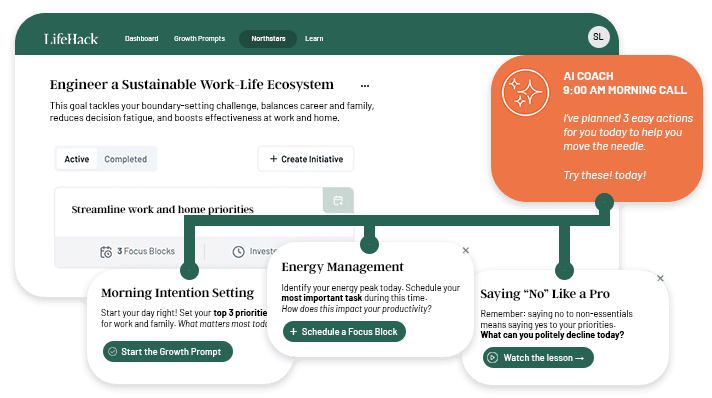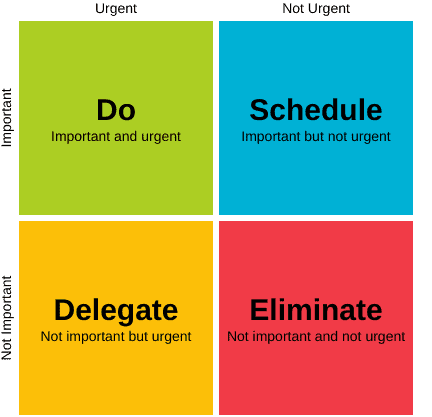It takes being productive to get things done correctly and on time. So how do you know which tasks are essential and which can wait? The answer is in the Prioritization Matrix, also known as the Eisenhower Matrix.
The matrix took its name after Dwight David Eisenhower.
Eisenhower was a general in the US army and the 34th President of the United States from 1953 to 1961. As a five-star general and a Supreme Commander in the US Army, he drafted the strategy for an Allied invasion of Europe.[1]
Eisenhower had to make tough decisions every time about which tasks to prioritize out of many he needed to focus on daily. So, he came up with the famous Eisenhower Matrix or the Prioritization Matrix.
Table of Contents
What Is the Prioritization Matrix?
A priority matrix is a tool for rating your tasks based on urgency. It helps you know the critical activities and those tasks that you should bypass and can be useful in project management, small businesses, or personal tasks.
Eisenhower famously said of the matrix:
“Most tasks that are urgent are not important, and most tasks that are important are not urgent.”
This quote became the maxim for Eisenhower in managing his time.
Benefits of the Prioritization Matrix
You’ll enjoy a lot of benefits by using the prioritization matrix. This tool is simple to use and straightforward. Apart from helping you make informed decisions, this tool will allow you to:
- Break down complex issues and prioritize them when numerous factors are affecting your decision-making process
- Rank your priorities unambiguously and objectively
- Determine the focal points
- Figure out what’s important and establish a basis for discussion
- Get stakeholder support when making important decisions
4 Quadrants in the Prioritization Matrix
There are four quadrants in the Prioritization Matrix, which help in comparing choices of what to do first and last, allowing you to prioritize projects and create strategic plan[2].
The quadrants are:
- Do
- Schedule
- Delegate
- Eliminate
1. Do
Do is the first quadrant in the Prioritization Matrix, and it incorporates important activities. That is, those tasks you need to carry out urgently — crises, deadlines, and issues that need your urgent attention and are highly relevant to your life mission.
How do you know which task falls into this quadrant?
Start by analyzing your priorities, and then establish if it falls within the ‘do it now’ criteria. If the task is achievable within a day, or within 24 to 48 hours, it’s urgent.
Another approach you can adopt in prioritizing tasks in this category is to adopt the “eat the frog” principle by Mark Twain. This principle recommends that you do the most urgent activities as soon as you wake up.
Here’s a practical example.
Let’s say you need to draft a content strategy and submit a report to your manager. It’s Saturday, and the deadline for submission is Monday. Can we say the activity is urgent? Definitely!
2. Schedule
The second quadrant of the prioritization matrix is Schedule. The Prioritization Matrix classifies tasks in this category as important but not that urgent.
They are long-term objectives and tasks with no immediate deadline. Those tasks could include meditation, journaling, studying, family time, and exercising.
Unlock Your Time Potential: From Chaos to Control
Discover how to reclaim your time and transform chaos into productivity with our comprehensive Time/Life Assessment.
If you're ready to take control of your time and boost your efficiency, don't miss this opportunity to get a personalized analysis and action plan.

You can plan out activities in this quadrant for some other period. For instance, you should exercise for good health, but you can allocate time to do it.
Schedule these activities in such a way that they don’t transfer to the “Do” or “Urgent” quadrant. Ensure you have sufficient time to carry them out.
3. Delegate
The third quadrant of the prioritization matrix is Delegate.
These tasks are not important to you but are quite urgent for others. This is where teamwork comes into play.
You can technically perform tasks in this category, but it makes sense to delegate them. Delegating tasks will ensure you have more time to pursue activities in your first two quadrants.
You should also monitor the tasks you have delegated. It will only amount to a sheer waste of time if you don’t have a tracking system for delegated tasks.
4. Eliminate
The last quadrant highlights your productivity killers. They are tasks that are not important to your goals and not urgent. The only way to boost your productivity is to eliminate them.
Some examples are constantly checking your phone, watching movies, or playing video games.
They could also be bad habits that you need to identify and delete from your daily and weekly schedule.
Successful people have learned how to prioritize and stick to what’s important. They have learned to find a better person for a task or eliminate less significant tasks.
Let’s consider two inspiring personalities that have designed their prioritization system.
Warren Buffet developed a two-list prioritization model to determine which task deserves his best attention. The bottom line is bypassing things that are important and useful but not top of the priorities.
Mark Ford, a business advisor, marketer, self-made millionaire, and author devised his strategy:
“Start work on the most crucial priority, take a break, work on the second most important task, take a break, then sort out the less important activities and any tasks he received from other individuals by afternoon.” [3]
When to Use Prioritization Matrix
You should always use a priority matrix when you want to compare choices and rank options based on predefined criteria of selection. This method will work for you when you want to:
1. Prioritize Projects
Not every project is created equally. Project teams and managers have to struggle with a wide range of hidden agendas to achieve the set objectives upon completing the project. To avoid wasting time and other precious resources, project teams should come up with selection criteria to prioritize projects that are most beneficial to them. These tasks should also have a high chance of successful implementation in the long term.
2. Manage Time Better
If a standard to-do list is no longer helping you improve your productivity, the prioritization matrix will be the ideal tool for you. It will help you determine the tasks that are urgent and critical that should be completed immediately and time-consuming tasks to avoid such as surfing the internet mindlessly.
3. Promote Consensus
As a marketing manager, your department likely has several projects that are competing for your attention. You need a logical and fact-based process to help you figure out the projects that need to be prioritized. Depending on the individual you ask, priorities will differ. Team members may require you to conduct extensive research on a particular area while another will encourage you to focus on building a branding strategy. A simple prioritization chat will help you in comparing choices to resolve conflicts and reach a consensus.
6 Easy Tips on How to Use Prioritization Matrix
Using the Prioritization Matrix can be tricky if you’re new at it, but by following a few simple steps, you can learn to utilize it in the best way possible.
1. List and Rank Your Priorities
Highlight all the tasks you need to carry out in a day. Then, classify them with weighted criteria based on urgency and importance.
Identify any activity that requires prompt action. I’m referring to a task that if you don’t complete that day, it could produce a grave consequence. For instance, if you don’t submit your content strategy, other content writers cannot work. It means you need to check for high-priority dependencies.
2. Define the Value
The next step is to examine the importance and assess which of them impacts your business or organization the most. As a rule of thumb, you can check which tasks possess higher priority over others. For instance, you need to attend to client’s requirements before you take care of any internal work.
You can also estimate value by examining how the task impacts the people and customers in the organization. In a nutshell, the more impact a task has on people or the organization, the higher the priority.
3. Take out the Most Challenging Task
Procrastination is not a symptom of laziness, but avoidance is. The truth is that you will typically avoid tasks you don’t want to do. The former CEO of Goldman Sachs, Lloyd Blankfein, once said he would take out the most dreaded task first thing when he got to the office.
Brian Tracy called these tasks the frogs you need to eat. That will remove the nagging dread, which mounts pressure on you when you postpone necessary tasks[4]. This is where the Prioritization Matrix can help; eat the “Do” frogs immediately.
If you need help overcoming procrastination, check out this article.
4. Know What’s Important to You
As long as you are in this cosmos, you will always encounter different choices that may be contradictory to your goals. For instance, a fantastic promotion that requires excessive travel will isolate you from important relationships. If you are not priority-conscious, you may accept it, even though your family is your priority.
Therefore, it makes sense to identify what is important to you and to prepare yourself not to compromise those important things for immediate pleasure or gain.
Yogi Berra captioned it this way:
“If you do not know your destination, you might end up somewhere else.”
5. Establish Regular “No Work” Time
YouTube CEO Susan Wojcicki established a rule not to check her emails between 6 pm and 9 pm. According to a CNN Business report, she was the first woman to request maternity leave when Google just got started. She prioritizes dinner time with her family despite being the CEO of YouTube[5].
Is it possible to cut out time for our relationships and interests outside of work?
Of course, and that’s why you need to set out your “no work” time. This approach will enable you to renew your energy levels for the next task. Also, you will be in the best position to introspect as you are not in your usual work zone.
6. Know When to Stop
You can achieve everything on your list sometimes. After you have prioritized your workload and assessed your estimates, remove the remaining tasks from your priority list and focus on your most urgent and important tasks.
Free Matrix Template
Here is the link to the free prioritization matrix template.
Conclusion
It’s not enough to be successful at work. Ensure you make out time for your family and an important relationship in your life.
Getting started and finding time may be tricky, but with some practice using the Prioritization Matrix, you’ll find that you are more productive and better able to divide your time between the things that are important to you.
Featured photo credit: William Iven via unsplash.com
Ready for a Goal Breakthrough? Unlock Your Personalized Strategy

Experience the power of a strategy tailored just for you.
Our personalized system provides:
- Custom-crafted action steps based on your unique situation
- Insights tailored to your specific challenges and strengths
- A personalized roadmap to turn your goals into reality
Tailored recommendations powered by smart analysis
Reference
| [1] | ^ | History: Dwight D. Eisenhower |
| [2] | ^ | Visual Paradigm: Eisenhower Matrix Example: Eisenhower Matrix Template |
| [3] | ^ | Mark Ford: Your Ultimate Productivity Guide for the New Year |
| [4] | ^ | Entrepreneur.com: First Things First: The 5 Secrets to Prioritization |
| [5] | ^ | CNNBusiness: Why YouTube’s chief wants parents to take more time off |
















































